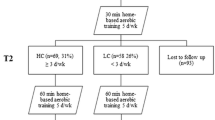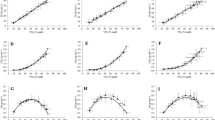Abstract
The purpose of the present study was to compare aerobic, anaerobic and strength performance changes induced by two short-term (3-week) body mass reduction programs based on the same low-calory diet (1200–1500 kcal/day), nutritional education and psychological counseling, but entailing different exercise training protocols. An individualized, low-volume and moderate-intensity exercise training (IET) was contrasted with a non-specific, high-volume, low-intensity exercise training (NET). Thirty obese in-patients (12 males, 18 females; mean age±SD: 33.9±9.4 yr, range: 19–51yr; mean BMI: 40.5±3.8 kg/m2, range: 35.3–51.4 kg/m2) were randomly divided in two gender-matched groups of 15 subjects each undergoing a different exercise training protocol. Maximum oxygen uptake (VİO2max) determined with a submaximal indirect test on a bicycle ergometer, lower limb maximum power output (Ẇmax) determined with the jumping method, global motor capabilities determined by analysis of locomotor pattern during a short (8 m) running, maximum strength (1-RM) of upper and lower limb muscle groups determined with isotonic machines were tested before and after the program. Adherence to an individual exercise activity and maintenance of body weight (bw) loss were evaluated with a telephonic interview 6 months after the completion of the program. In both groups a significant (p<0.001) and comparable weight loss was observed (IET: −4.27%; NET: −4.17%). In both groups VİO2max and Ẇmax increased significantly (p<0.05–0.001) when expressed relatively to body mass, while in absolute terms they were significantly (p<0.001) improved only in IET group. 1-RM in all tested muscle groups was significantly increased in both IET and NET subjects (p<0.001–0.01), but improvements were significantly greater in IET as compared with NET (p<0.05–0.001). The analysis of locomotor pattern during the short running indicated that IET subjects significantly improved their global motor capabilities (p<0.05–0.001), while no change was observed in NET group. After 6 months, IET subjects reported a level of spontaneously chosen physical activity significantly higher (p<0.05) than NET subjects, displaying a trend of further decrease in bw. It was concluded that, although no difference in bw loss was appreciated between the two studied groups and significant improvements were found also in subjects performing NET protocol, the IET protocol offers better overall results in terms of muscle performance and physical fitness, with a possibly stronger motivation to subsequent exercise activity.
Similar content being viewed by others
References
Flegal K.M. The obesity epidemic in children and adults: current evidence and research issues. Med. Sci. Sports Exerc. 1999, 31: S509–S514.
Mokdad A.H., Serdula M.K., Dietz W.H., Bowman B.A., Marks J.S., Koplan J.P. The continuing epidemic of obesity in the United States. J. Am. Med. Assoc. 2000, 284: 1650–1651.
Must A., Spadano J., Coakley E.H., Field A.E., Colditz G., Dietz W.H. The disease burden associated with overweight and obesity. J. Am. Med. Assoc. 1999, 282: 1523–1529.
Allison D.B., Fontaine K.R., Manson J.E., Stevens J., Vanltallie T.B. Annual deaths attributable to obesity in the United States. J. Am. Med. Assoc. 1999, 282: 1530–1538.
Jebb S.A., Moore M.S. Contribution of sedentary lifestyle and inactivity to the etiology of overweight and obesity: current evidence and research issues. Med. Sci. Sports Exerc. 1999, 31: S534–S541.
Di Pietro L. Physical acitivity in the prevention of obesity: current evidence and research issues. Med. Sci. Sports Exerc. 1999, 31: S542–S546.
Wing R.R. Physical activity in the treatment of adulthood overweight and obesity: current evidence and research issues. Med. Sci. Sports Exerc. 1999, 31: S547–S552.
Pavlou K.N., Steffee W.P., Lerman N.H., Burrows V. Effects of dieting and exercise on lean body mass, oxygen uptake, and strength. Med. Sci. Sports Exerc. 1985, 17: 466–471.
Ross R., Rissanen J., Padwell H., Cliffort J., Shragge P. Influence of diet and exercise on skeletal muscle and adipose tissue in man. J. Appl. Physiol. 1996, 81: 2445–2455.
Lafortuna C.L., Fumagalli E., Vangeli V., Sartorio A. Lower limb alactic anaerobic power output assessed with different techniques in morbid obesity. J. Endocrinol. Invest. 2002, 25: 134–141.
Sartorio A., Lafortuna C.L., Conte G., Faglia G., Narici M.V. Changes in motor control and muscle performance after a short-term body mass reduction program in obese subjects. J. Endocrinol. Invest. 2001, 24: 393–398.
Sartorio A., Narici M.V., Fumagalli E., Faglia G., Lafortuna C.L. Aerobic and anaerobic performance before and after a short-term body mass reduction program in obese subjects. Diab. Nutr. Metab. 2001, 14: 51–57.
Åstrand P-O., Rhodal K. Textbook of Work Physiology, ed. 2. McGraw-Hill Book Company, New York, 1977, p. 681.
Mayhew J.L., Prinster J.L., Ware J.S., Zimmer D.L., Arabas J.R., Bemben M.G. Muscular endurance repetitions to predict bench press strength in men of different training levels. J. Sports Med. Phys. Fitness 1995, 35: 108–113.
Bosco C., Luhtanen P., Komi P.V. A simple method for measurement of mechanical power in jumping. Eur. J. Appl. Physiol. S 1983, 50: 273–282.
Sartorio A., Lafortuna C.L., Silvestri G., Narici M.V. Effects of short-term, integrated body mass reduction program on maximal oxygen consumption and anaerobic alactic performance in obese subjects Diab. Nutr. Metab. 2003 (in press).
Jackson A.S., Blair S.N., Mahar M.T., Wier L.T., Ross M., Stuteville J.E. Prediction of functional aerobic capacity without exercise testing. Med. Sci. Sports Exerc. 1990, 22: 863–870.
Shephard R.J. Intensity, duration, and frequency of exercise as determinants of the response to a training regime. Int. Z. Angew. Physiol. 1968, 26: 272–281.
Gaesser G.A., Rich G.A. Effects of high- and low- intensity exercise on aerobic capacity and blood lipids. Med. Sci. Sports Exerc. 1984, 16: 269–275.
Staron R.S., Karapondo D.L., Kraemer W.J., et al. Skeletal muscle adaptations during early phase of heavy-resistance training in men and women. J. Appl. Physiol. 1994, 76: 1247–1255.
Enoka R.M. Muscle strength and its development: new perspectives. Sports Med. 1988, 6: 146–168.
Kraemer W.J., Volek J.S., Clark K.L., et al. Influence of exercise training on physiological and performance changes with weight loss in men. Med. Sci. Sports Exerc. 1999, 31: 1320–1329.
Sartorio A., Lafortuna C.L., Massarini M., Galvani C. Effects of different training protocols on exercise performance during a short-term body weight reduction program in severely obese patients. Eating Weight Disord. 2003, (in press).
Sartorio A., Lafortuna C.L., Vangeli V., Tavani A., Bosetti C., La Vecchia C. Short-term changes of cardiovascular risk factors after a non pharmacological body weight reduction program. Eur. J. Clin. Nutr. 2001, 55: 865–869.
Oman R.F., King A.C. Predicting the adoption and maintenance of exercise participation using self-efficacy and previous exercise participation rates. Am. J. Health Promot. 1998, 12: 154–161
Author information
Authors and Affiliations
Corresponding author
Rights and permissions
About this article
Cite this article
L, C., Resnik, M., Galvani, C. et al. Effects of non-specific vs individualized exercise training protocols on aerobic, anaerobic and strength performance in severely obese subjects during a short-term body mass reduction program. J Endocrinol Invest 26, 197–205 (2003). https://doi.org/10.1007/BF03345157
Accepted:
Published:
Issue Date:
DOI: https://doi.org/10.1007/BF03345157




